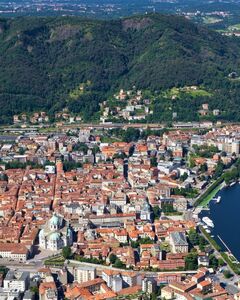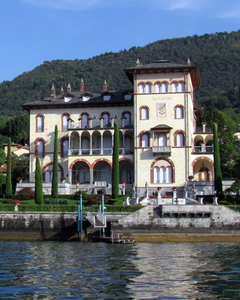
museums near Albergo Sala Spa


The family bankers Amsick from Hamburg bought several properties in the enchanting corner of San Giovanni. The project involved demolition of some houses, silk factories, and three villas overlooking a lake. For this reason, in San Giovanni there is...
An outdoor museum focusing on Abstract Sculpture with an exhibition area of more than 120 acres. The Rossini Art Site resonates in many ways with its founder’s desire to create a flexible, friendly and enjoyable place for families. At RAS, kids can...
A guided tour that tells the story of the radio that will provide insight and memories from the olden days before flat screen TVs and the Internet....
A small museum housing artifacts, images and posters describing the history of granite processing in Novate Mezzola. Sanfedelino. For nearly two centuries, extracting granite from the Sanfedelino quarry, so called to recognize the martyr Fedele...
Ancient and modern printing, from mobile characters to computers is the theme of this museum. Here one can see antique-type lithographic presses, machines for the casting of the lead characters, the first cameras dating back from the end of...
Visit a century old mine and see the techniques employed to extract barite an important mineral used to refine sugar, in rubber, coated papers, pigments, glues, plastics and in protective materials against radiation. The material comes out the...
The baths date from the first century A.D. to the present day. Since the second half of the first century AD, the remains of Roman baths were spread over an area of about 1500 square meters. Thanks to recovery work in recent years, the baths are now...
Educational science museum that was inaugurated in 1917 aiming at providing educational tools for teaching science in school. The room that hosts the museum is painted with frescos inspired by nature and displays images of all Nobel Laureates who...
Located on the top floor of Riva 1920, a notable furniture manufacturer. It houses over 4,000 historic woodworking machines and tools. This is the biggest of such collections in the whole of Italy. The aim of the exhibition is to rediscover the...
A museum that aims to preserve and offer an account of country life in the late nineteenth and early twentieth century, documented by artifacts and various objects. The museum is located on two floors: the first one is set up as a home environment...
A series of sculptures and paintings of Italian and European artists, creating a veritable outdoor museum while respecting the area’s pristine landscape. The works have been created by various artists with the intent of both beautifying and...
The House Museum of Moggio was commissioned in 1991 by Maria Goretti who, donated the property to the parish with the stipulation that it be used to benefit the community. The Museum includes historical objects, old photographs, fossils and minerals...
Contains a collection of natural history (fossils, minerals, dioramas of animals and a butterfly collection), archaeological and ethno-anthropological material with a reconstruction of a "Casel ", the typical hut of Maggengo. It is the first local...
Gallery space that promotes various forms of art to ordinary people, trying to combine accessibility and quality, local and universal dimension, past and present. If we want people to love culture we have to give them a reason to love it. During the...
In addition to its lavish gardens and picturesque position on the lake, Villa Monastero is also a house museum where a vast number of objects belonging to its several owners are displayed....
Thanks to Giambattista Sommariva the villa reached its greatest glory in the 18th century, being enriched by art masterpieces and becoming a museum. Sommariva was an art collector and bought the estate at the beginning of the century; he enhanced...
The Museum holds records of the local history, traditions and customs. Several natural environments are recreated complete with plants, animals, mushrooms fossils and dioramas relating to the local fauna. The museum also has documents about the...
In 1978 a group of friends of the Lake of Como founded an association called "The Collection of Boats of Lake Como" with the aim of saving the age-old and noble nautical traditions of their lake. The museum was opened in 1982 and it is fitted out in...
The Palace was then the scene of memorable historical facts and today becomes the perfect setting for their commemoration museum. Thus it was born in Dongo the innovative Museum of the End of the War: a virtual tour and interactive in the depths of...
The Toy Horse Museum is the first and to date only museum in the world dedicated to the horse toy. The Museum is located in what was once the stables of the famous trotter Tornese that in the fifties was more times world champion. In 1969, the...
Exhibition space for cultural events as contemporary art exhibitions, conferences, concerts and living-performances. One of the better known examples is MiniArtTextil—an annual international exhibition of contemporary art showing the best in Textile...
Our Museum: a voice which recounts to the future generations the importance of the events that took place in Dongo in April 1945. The last page of the WWII’s history was written here: the tragic tale of a war and a dictatorship which was responsible...
The Museum extends over a surface of 1000 square metres and its exhibits reconstruct the silk manufacturing process with an historical and educational approach. The visitor is given the opportunity to learn more about both the whole process and the...
Como’s Archaeological Museum Paolo Giovio is housed in the Palazzo Giovio, and features collections from prehistoric and antiquity eras. The building, dating back to the late Middle Ages, underwent some changes in the sixteenth century by Benedetto...
What is today the Giuseppe Garibaldi Museum was once a residential building, which hosted Garibaldi during his campaigns for independence. Within its walls, is an impressive collection of dresses, weapons, documents and furniture of the...
The “Luigi Scanagatta" museum is of cultural and historical importance because of the number of birds specimens that was gathered throughout the years and its history. It was established in 1962 by professor Luigi Scanagatta, a well known...
Civic museum and gallery with artifacts and paintings from the Middle Ages, Renaissance and contemporary works....
The Volta Temple is a museum dedicated to Alessandro Volta, a prolific scientist and the inventor of the electrical battery. Volta was born in Como in 1745, held his first professorship there until 1779, and retired to Como in 1819. It is one of the...